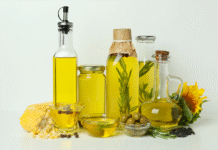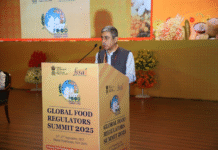
The Food Safety and Standards Authority of India (FSSAI) has released the full report on the ‘National Milk Safety and Quality Survey 2018’. The survey results demolish the perception of large-scale milk adulteration in the country.
This Milk Survey was conducted from May 2018 to October 2018 covering all States and UTs to monitor the safety and quality of liquid milk in the country. A total of 6,432 samples of milk were collected from 1,103 towns or cities with a population above 50,000, representing both organized (retailers and processors) as well as non-organized (local dairy farms, milk vendors and milk mandis) sectors. The number of samples collected was linked to the population at the sampling locations and covered different types of milk (raw and processed of various types).
The survey has shown that 12 out of 6,432 samples of milk were adulterated that render such milk unsafe for human consumption. Six samples were found adulterated with hydrogen peroxide, three with detergents, two with urea and one sample was found to have neutralizers. No samples were found with boric acid and nitrates, the other two possible adulterants. Out of 12 adulterated samples, nine were in Telangana, two from Madhya Pradesh and one from Kerala. While, there is a concern, but this dispels the widespread perception that liquid milk in the country is largely adulterated.
A major finding in the survey was the presence of Aflatoxin M1 residues beyond permissible limits in 368 (out of 6,432) samples, which is 5.7% of the samples. This is the first time that such a detailed survey of the presence of Aflatoxin M1 in milk has been done in the country. Aflatoxin M1 comes in the milk through feed and fodder, which are currently not regulated in the country. This problem is more dominant in processed milk rather raw milk. The survey further showed that 77 (out of 6,432) samples, that 1.2 % of the samples had residues of antibiotics above the permissible limits.
This is the first time that a quantitative analysis of all samples that failed on account of adulterants and contaminants has been done. It is found that the level of adulterants and contaminants in failed samples is not high, therefore unlikely to pose a serious threat to human health. FSSAI is however committed to zero tolerance for any adulteration and contamination of milk. The survey has helped in the identification of hot spots so that more intensified efforts for surveillance and enforcement could be taken up in such areas.
The stakeholders’ group further deliberated on the presence of ammonium sulphate in milk. After careful review of scientific opinion, the group concluded that ammonium sulphate is coming into the milk naturally and is safe and not a contaminant as earlier thought. It was noted that ammonium sulphate is allowed as an additive in certain foods in several countries.
Overall, above 93% of the samples that is 5976 (out of 6,432) samples were found to be safe for human consumption. This is undoubtedly good news for Indian consumers. The survey, however, showed that about 41% of samples, though safe, fall short of one or another quality parameter. Both raw and processed samples were found non-compliant on account of low fat or low SNF (solid not fat) or both.
The proportion of fat and solid non-fat (SNF) in milk varies widely by species and depends on breed as well as the quality of feed and fodder. Cattle must be properly fed and good farm practices must be adopted to improve the amount of fat and SNF in milk. Non-compliance with these parameters in raw milk could be for these reasons or due to the dilution of milk with water. Non-compliance of fat and SNF in standardized or processed milk is however surprising.
The presence of Maltodextrin in 156 (out of 6432) samples and Sugar in 78 (out of 6432) samples is yet another surprise. This mainly confined to processed milk. Maltodextrin and sugar are not unsafe but added to raise the level of fat and SNF. While, these do not represent a threat to human health, but stringent action is required to curb this wrong practice. The survey did not find any non-compliance on account of other parameters such as cellulose, glucose, starch, and vegetable oil in the collected samples.
While all samples were tested on the spot for critical parameters of quality and safety, samples that failed on account of contaminants and adulterants were subjected to confirmatory analysis. This was done by proficient analysts in NABL-accredited and FSSAI-recognized laboratories using high-end equipment and employing established testing protocols. This survey has been carried out by an independent third-party agency.
The outcome of the survey is a myth buster. The survey results indicate clearly that milk being sold in India is largely safe for consumption. This is contrary to the widespread perception of large-scale milk adulteration in the country based on deceitful campaign and unsubstantiated reports. Further, the results of the previous two experimental surveys by FSSAI have also been grossly misrepresented causing unnecessary scare in the minds of the consumers.
It is imperative that the safety and quality of milk are maintained. FSSAI Survey has clearly shown that while milk is largely safe milk, contamination due to Aflatoxin M1 and Antibiotic residues is a more serious problem than milk adulteration and the quality concerns persist. While combatting adulteration requires more vigilant citizens and enforcement machinery, contamination in milk requires systemic improvements through the supply chain. And that is being done!
IndiFoodBev — authentic, impactful and influential
An English-language food and beverage processing and packaging industry B2B platform in print and web, IndiFoodBev is in its third year of publication. It is said that the Indian food and beverage industries represent approximately US$ 900 billion in revenues which implies more than 20% of the country’s GDP. Eliminating the wastage on the farmside can help to deliver more protein to a higher number of the population apart from generating sizable exports. The savings in soil, seeds, water, fertilizer, energy and ultimately food and nutrition could be the most immense contribution that country is poised to make to the moderation of climate change.
To improve your marketing and grow sales to the food and beverage processing and packaging industry, talk to us. Our research and consulting company IppStar [www.ippstar.org] can assess your potential and addressable markets in light of the competition. We can discuss marketing, communication, and sales strategies for market entry and growth.
Suppliers and service providers with a strategy and budget for targeted marketing can discuss using our hybrid print, web, video, and social media channels to create brand recognition linked to market relevance. Our technical writers are ready to meet you and your customers for content.
The second largest producer of fruit and vegetables in the world is continuously expanding processing capacities and delivery systems with appropriate innovative technologies. We cover product and consumer trends, nutrition, processing, research, equipment and packaging from farm to thali. Get our 2025 media kit and recalibrate your role in this dynamic market. Enhance your visibility and relevance to existing markets and turn potential customers into conversations. Ask for a sample copy of our bi-monthly in print or our weekly IndiFoodBev eZine each Wednesday.
For editorial info@ippgroup.in — for advertisement ads1@ippgroup.in and for subscriptions subscription@ippgroup.in
Naresh Khanna – 10 February 2025
Subscribe Now











